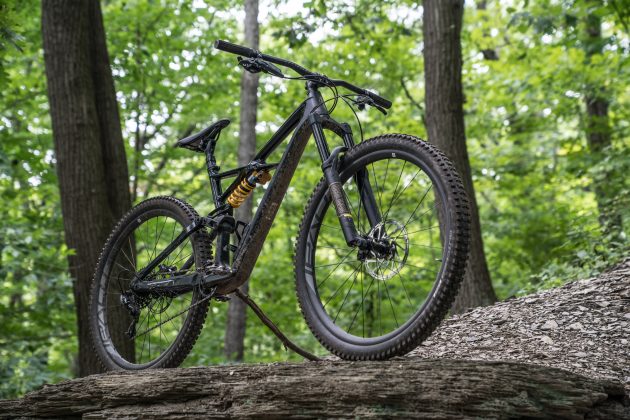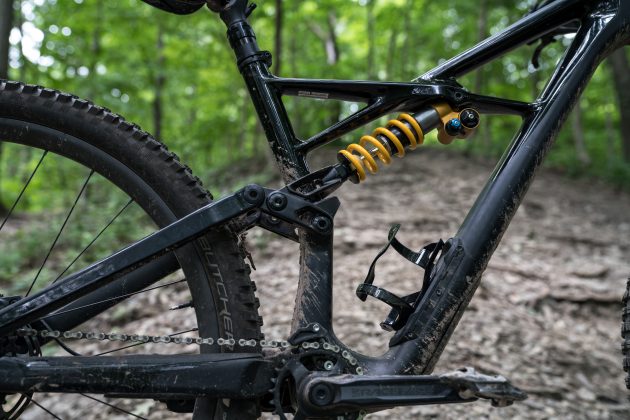Review: Specialized Enduro Coil 29
Originally posted on December 31, 2018 at 0:01 amEditor’s note: This review originally appeared in issue 207 of Dirt Rag Magazine. Like what you see? Subscribe now at dirtragmag.com/subscribe to catch issue 209, coming real soon.
Tester: A.J. Collins
Age: 40
Height: 5’10”
Weight: 165 lbs.
Inseam: 31”
Price: $5,800
Sizes: S, M, L (tested), XL
Online: specialized.com
Reach: 18.2”
Stack: 24.4”
Top Tube: 24.1
Head Tube: 66°
Seat Tube: 76.7°
BB Height: 13.9”
Chainstays: 17”
Weight: 32 lbs w/o pedals
INTRO
At first, Specialized’s Enduro Coil 29 seemed like a weird one to me. On one hand, it mates the brand’s high-end carbon frame and rims with the same Öhlins coil-sprung suspension used by its Enduro World Series racers. But on the other hand, its component spec might be lifted from a rental fleet: heavy budget drivetrain and cockpit, and slow-engaging house-brand hubs. So who is this bike for, anyway?
What we have then is a gravity-oriented ride with a boutique coil suspension and burly parts that are cheap to replace. And, considering that the Enduro Coil weighs in over 32 pounds without pedals, it seems less suited to racers than to riders content with winching up fire roads to bomb long and fast descents. So that’s what I did when I tested it.

FRAME DETAILS
Specialized has returned to a tried-and-true 73 mm threaded bottom bracket and the internal cable-routing tubes running through the carbon frame. A tiny multi-tool is stashed beneath a swiveling steerer-tube top cap. Given, tool selection is limited, but if it sounds like a gimmick, think of all the times you didn’t stop to tweak your cockpit because your tool was out of immediate reach. Less handy is a chain tool accessed through the bottom of the steerer tube. Fortunately, I never had to fish it out.
Also new is Specialized’s Command Post IRcc WU dropper post, which tilts the seat as it’s lowered. This allows the back of seat a full 150 mm of drop, but the post itself drops only 115 mm. I’ve never really cared about my seat angle when it was dropped, so long as it was out of the way, but with the WU I found that I could use the inside of my thigh for more effective body English when throwing the bike around. I’m not sure if that stemmed from the WU’s improved seat angle, or because the post drops less than I’m used to, leaving the nose of the seat there for me to use, whether I liked it or not. Fortunately, I did like it. It never felt like a groin torch, and the angle let me float off the back when rolling into stupid-steep slabs.

GEOMETRY AND SIZING
For 2018, Specialized keeps up with current geometry trends, lengthening the reach from 17.7 to 18.2 inches, and shortening the stack from 24.5 to 24.4 inches for a size large. The head angle remains at 66 degrees, but now there’s a removable spacer at the base of the shock that slackens the head 0.5 degrees and drops the bottom bracket 0.3 inches. This isn’t an easy “flip chip” switch, but if you’re racing or dropping into steep lines at the park, it’s a change you’ll want to make. If these “longer, lower, slacker” aspects serve to amplify the bike’s descending capabilities, it all shakes hands nicely with the Enduro’s 17-inch chainstays to stay snappy in tight singletrack corners, and the steep 76-degree seat-tube angle keeps you from perching on your saddle’s nose and punishing your prostate on protracted climbs.
SETUP
The Öhlins TTX shock arrived with a 480-pound spring for my 165 pounds. This put me just over the recommended 30 percent sag with the high-speed compression wide open, though measuring sag was a bit of a pain without the familiar O-ring found on air shock shafts. I would’ve liked a 502-pound spring for high-speed runs, but the 480 never bottomed out harshly, and I never lacked for traction.
Both the compression and rebound damping are standouts on the TTX and the RFX fork, and setup was refreshingly straightforward. The TTX has 16 clicks of low-speed compression, and I settled right in the middle at eight clicks. High-speed compression has three settings that translate to “Descend, Level, Climb” – more on that in a bit.

RIDE
“Take a load off, Fanny — Take a load for free …” Levon Helm’s soul-clenched largesse rang in my ear not far up Bear Gap Road, a long and steep pitch that was my first real climb aboard the Enduro Coil. I was headed up to the extended granite chute that is Croyle Run in central Pennsylvania’s Rothrock State Forest. That chorus from “The Weight” was one I’d hear many times in the coming months, some helping and some heckling, as I sat and spun the 33 pound-plus machine into elevation.
If the shock in the open mode is a good match for the Enduro’s descending chops, it does serve up some soggy pedaling when going up. On rocky, rooty climbs, I was content with the shock’s middle setting. This kept the suspension very active, and while there was still plenty of pedal bob, there was also gobs of grip allowing me to climb up and over all kinds of terrible looking stuff.
Occasionally, I’d “lock out” the shock to boost efficiency when scaling lesser chunder. Even then, there was enough action to keep the tires planted, but I could stand and hammer up a techy pitch. During these efforts, the RFX fork simply glided and guided my front wheel over smaller obstacles with little shrugs. It’s a fine, fine fork. Winding up long climbs, the Enduro’s weight is what it is: heavy. But with the fork and shock locked out as much as possible, I was okay with how the bike wore its weight.
While I usually despise messing with switches while riding, the TTX shock’s three-position high-speed compression lever definitely got used to having its snoot booped. So often, in fact, that I found myself wanting a remote switch when I was on terrain with alternating brief pedally sections and technical descents, as are often found on East Coast trails.
This bike is a wholesale locomotive on big descents. But I didn’t have to plow rock gardens to feel the suspension earning its keep. Despite not being tuned specifically for my weight and riding preferences, the TTX worked really well with my more agile, smooth approach. I would put it a tick above Fox’s DHX2 and Cane Creek’s DB Coil CS in terms of small bump compliance and adjustability. Cane Creek’s DB Coil CS has a more effective climb switch.
Despite all its heft and traction, the Enduro is pretty easy to toss around and doesn’t resist taking flight. Bikes with this much travel and weight often excel at going fast because they hug the ground. On descents with any amount of speed, the Enduro excels at popping and responding to nudges when I want to air over a clutch of granite fists. I chalk this up to the bike’s fore-aft balance, which nestles you “in” the bike as much as any I’ve ridden. It’s a feeling that also encouraged me to ride very centered when I might’ve been tempted to drift off the back as I reached my velocity comfort level. It’s hard not to personify this machine as wanting to go fast – flying into sketchy corners and flinging around berms were equally hoot-inducing.

CONCLUSION
All this adds up to a capable bike that’s a blast on just about any kind of descent. But the Enduro Coil 29 should not be confused with some of do-it-all quiver-killer. Sure, it can handle 40-mile days with 4,500+ feet of climbing – but it’s gonna hurt. This bike wants to go down, fast. Seeing that as the case, it’s odd that Specialized didn’t include the Öhlins coil suspension on its S-Works parts spec. As it sits, what could be a true enduro race machine is taken down a few notches by the Race Face Aeffect crank, SRAM GX drivetrain, and slow-engaging rear hub, although these are in line with the price tag. These parts are serviceable enough, though, so if you want a burly rig for gravity-oriented days rewarded by the cool consistency that coil springs provide, the Enduro Coil 29 could be your calling.
